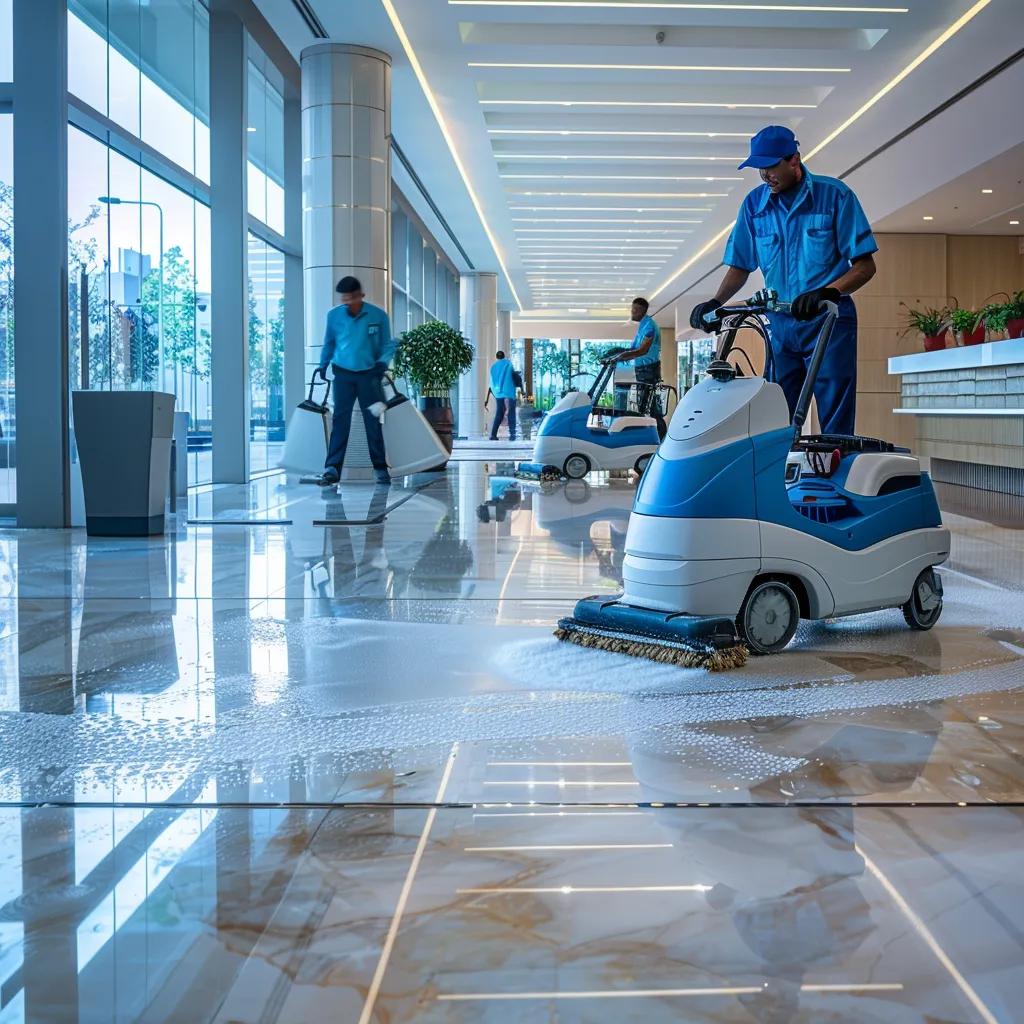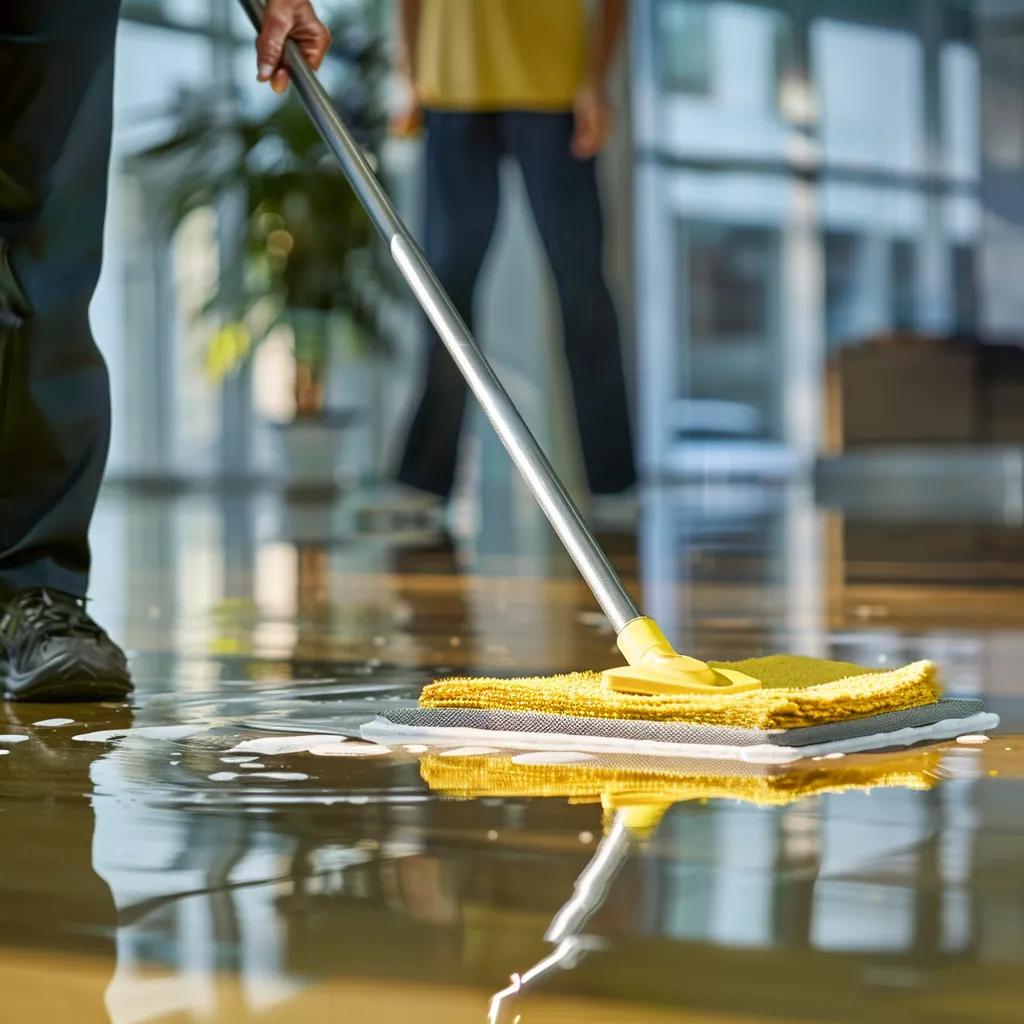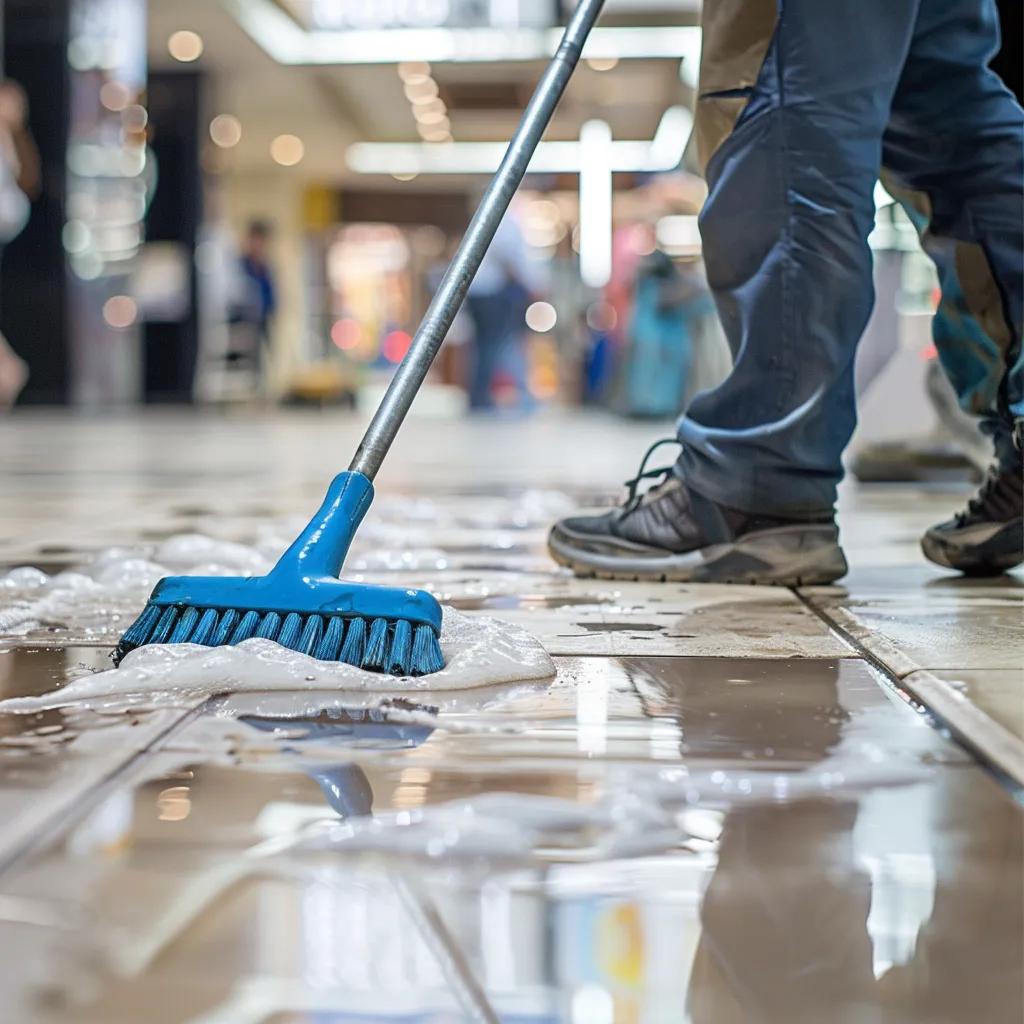
What Are the Best Floor Care Methods for Efficient Commercial Floor Maintenance?

Commercial spaces invest heavily in flooring, yet improper upkeep can erode up to 20% of value within five years. floor maintenance
Efficient floor maintenance strategies combine tailored cleaning methods, scheduled protocols, and professional expertise to preserve appearance, safety, and longevity. This guide maps the best practices across seven key areas:
- Specialized Care by Flooring Type
- Essential Techniques & Schedules
- Benefits of Professional Maintenance
- Solutions for Common Challenges
- Selecting Services & Equipment
- High-Traffic Area Protocols
- Local Considerations in Macomb & Oakland Counties
By following these methods, businesses in Metro Detroit can reduce replacement costs, minimize slip hazards, and support healthier indoor office cleaning environments.
What Types of Commercial Flooring Require Specialized Care?
Commercial flooring encompasses diverse materials—each demanding specific cleaning actions to maintain structural integrity and finish quality. Tailored care prevents premature wear, protects investment, and enhances workplace safety. For example, hardwood benefits from pH-neutral cleaners and micro-mopping, while concrete relies on degreasers and sealants to withstand heavy loads.
Before diving into methods, here is a comparison of common floor types and their maintenance needs:
| Floor Type | Cleaning Method | Key Benefit |
|---|---|---|
| Hardwood | Daily dust mopping; neutral cleaner | Preserves finish and sheen |
| Tile & Grout | Grout-brush scrubbing; sealing | Prevents discoloration |
| Carpet | Hot water extraction; vacuuming | Reduces allergens |
| Vinyl & Laminate | Damp mop with vinyl-safe solution | Protects against moisture |
| Concrete | Automatic scrubbing; acid neutral cleaner; sealing | Extends service life |
These distinct routines set the stage for targeted practices, ensuring each surface receives the right attention.
How Should Hardwood Floors Be Maintained in Business Environments?

Hardwood floors require gentle cleaning to avoid surface abrasion and finish dulling. Daily dust mopping removes grit, while monthly applications of a pH-neutral cleaner restore shine and inhibit surface scratches. Periodic refinishing every 2–3 years renews protection and keeps wood fibers sealed against moisture. For more information, visit our floor maintenance section.
- Use a microfiber dust mop at the start of each shift.
- Apply diluted, pH-balanced cleaner with a damp mop once weekly.
- Schedule professional refinishing to replenish protective coating.
Closing this care cycle with annual inspection prevents minor damage from becoming costly refinishing projects and transitions naturally to tile and grout maintenance.
What Are the Best Practices for Tile and Grout Cleaning in Commercial Spaces?

Tile flooring accumulates dirt in grout lines where water and traffic embed soils. A specialized grout cleaner combined with a stiff‐bristled brush dissolves grime at the source, while sealing grout every six months forms a moisture barrier that resists stains and microbial growth.
- Sweep or vacuum to remove loose debris.
- Apply grout cleaner and agitate with a grout brush.
- Rinse tile surface thoroughly and dry with a squeegee.
- Seal grout lines to lock out moisture and spills.
Consistent tile care not only preserves aesthetics but also prevents slip hazards, creating a safer environment that leads into comprehensive carpet maintenance solutions.
How Can Businesses Effectively Clean and Maintain Commercial Carpets?
Commercial carpets trap dust, allergens, and bacteria, requiring deep hot water extraction to flush contaminants from fibers. Regular vacuuming three times weekly lifts surface soils, while spot treatments address spills before staining occurs. For more information on our cleaning methods, visit our commercial carpet cleaning service.
| Entity | Attribute | Value |
|---|---|---|
| Carpet | Vacuum Frequency | 3× per week |
| Carpet | Deep Cleaning Method | Hot water extraction biannually |
| Stains | Spot Treatment Agent | Enzyme-based carpet cleaner |
Implementing this two-pronged approach maintains indoor air quality and prepares facilities for adjacent vinyl and laminate floor care.
What Floor Care Methods Work Best for Vinyl and Laminate Floors?
Vinyl and laminate surfaces benefit from controlled moisture and mild detergents that lift dirt without warping or delaminating layers. Damp mopping with a vinyl-safe cleaner preserves protective wear layers, while avoiding waxes that can leave slippery residues. Floor maintenance is essential for longevity.
- Remove loose debris with a soft-bristle broom daily.
- Damp mop using a neutral, non-abrasive solution twice weekly.
- Dry surface immediately to prevent moisture damage.
A consistent routine prevents edge lifting and supports neighboring concrete floor protocols.
How Should Concrete Floors Be Cleaned and Sealed for Longevity?
Concrete floors demand heavy-duty degreasers and auto scrubbers to remove ingrained soils in industrial settings. After cleaning, applying a penetrating sealer fills pores and resists oil penetration, extending surface life and simplifying future maintenance.
| Entity | Attribute | Value |
|---|---|---|
| Cleaning Tool | Auto Scrubber | Removes deep-set soils |
| Cleaning Agent | Alkaline Degreaser | Dissolves oil and grease |
| Coating | Penetrating Sealer | Blocks moisture and stains |
Sealing concrete transforms a porous surface into a resilient platform, paving the way to schedule-based techniques in the next section.
What Are the Essential Floor Care Techniques and Cleaning Schedules?
Effective floor maintenance combines daily, weekly, and monthly protocols that align cleaning intensity with traffic levels. Scheduled workflows optimize resource allocation, safeguard finishes, and support consistent appearance.floor maintenance
What Does a Daily, Weekly, and Monthly Commercial Floor Cleaning Schedule Include?
A structured timetable ensures no task is overlooked, balancing light upkeep with deeper interventions that preserve
and appearance.
| Frequency | Task | Purpose |
|---|---|---|
| Daily | Sweeping, dust mopping | Removes loose debris |
| Weekly | Damp mopping, stain treatment | Cleans spills, refreshes surface |
| Monthly | Auto scrubbing, buffing | Restores finish and removes buildup |
This schedule framework streamlines operations, guiding businesses into advanced scrubbing and buffing techniques.
How Do Advanced Floor Scrubbing and Buffing Techniques Improve Floor Care?
- Auto scrubbers ideal for large expanses remove 99% of dry soils.
- Floor buffers apply finish evenly and minimize streaking.
- Dual-brush machines adapt to both tile and sealed concrete.
Integrating mechanized processes increases efficiency and transitions smoothly to the next topic on equipment selection.
Which Commercial Floor Cleaning Equipment Is Most Effective?
Choosing the right tools accelerates cleaning cycles and improves outcomes. Industrial vacuums, auto scrubbers, and burnishers form the core of any commercial program.
- Industrial Vacuum Cleaner – Captures fine dust on hard and soft surfaces.
- Walk-Behind Auto Scrubber – Cleans up to 32,000 ft² per hour.
- High-Speed Burnisher – Polishes floors to a high gloss finish.
Equipping teams with these machines ensures readiness for selecting and applying the correct cleaning solutions.
How Should Commercial Cleaning Solutions Be Selected and Applied?
Effective cleaning solutions combine proper pH balance with safety and eco-friendliness. Neutral pH cleaners protect finishes, while biodegradable detergents support sustainability goals. For more information, visit
.
- Match cleaner pH to floor type (acidic for stone, alkaline for grease).
- Dilute according to manufacturer guidelines for optimal concentration.
- Apply with low-profile micro-fiber pads to prevent streaking.
Correct product selection safeguards surfaces and prepares facilities for professional care impacts.
Crafting Effective Commercial Floor Maintenance Strategies
Professional maintenance leverages expertise, machinery, and specialized products to deliver results that DIY approaches cannot match. Expert care maximizes return on investment and minimizes liability.
Why Does Professional Cleaning Prolong the Life of Commercial Floors?
Routine professional interventions remove abrasive particles and restore protective coatings before they erode. This proactive maintenance reduces wear patterns and delays the need for costly replacements.
- Deep cleaning annually removes embedded grit from seams.
- Periodic stripping and recoating restores barrier layers.
- Scheduled inspections catch damage early, enabling timely repairs.
Extending floor life with professional services naturally improves safety metrics as well.
How Does Expert Floor Maintenance Reduce Slip Hazards and Improve Safety?
Professional protocols target residue removal and finish uniformity, eliminating slick spots and uneven surfaces that cause falls. Proper traction and dry-surface techniques lower incident rates. Floor maintenance is crucial for ensuring safety and performance in any environment.
- Residue-free mopping – Removes soap films that create slipperiness.
- Anti-slip coatings – Enhance grip in wet areas.
- Routine inspections – Identify and correct hazards before accidents occur.
A safer floor environment also supports healthier indoor air. floor maintenance
In What Ways Does Professional Floor Care Improve Indoor Air Quality?
Specialized extraction equipment lifts allergens, dust mites, and mold spores trapped in carpet fibers and grout lines. This reduction in airborne particulates promotes respiratory health across facilities.
| Entity | Attribute | Value |
|---|---|---|
| Carpet Extraction | Particle Removal | Up to 95% of allergens eliminated |
| Grout Cleaning | Mold Prevention | Seals out microbial growth |
| Dry-Surface Buffing | Dust Minimization | Reduces airborne dust by 85% |
Cleaner air contributes to employee well-being and sets the stage for cost-benefit analysis.
What Are the Cost Benefits of Outsourcing Commercial Floor Cleaning?
Outsourcing transfers labor, equipment, and supply management to specialists, yielding predictable budgets and freeing internal teams for core business activities. Bulk supply purchasing and optimized routes lower per-square-foot expenses.
- Fixed monthly contracts simplify budgeting.
- Consolidated service areas reduce mobilization costs.
- Professional warranties cover accidental damage.
These efficiencies demonstrate why professional care outperforms in-house efforts and lead into specialized solutions.
What Specialized Floor Care Solutions Address Common Commercial Challenges?
Commercial facilities confront spills, heavy soils, and emergency incidents that standard routines cannot resolve. Specialized treatments restore appearance and function swiftly. Commercial cleaning
How Can Stubborn Stains Be Removed from Commercial Floors?
Targeted stain removal employs enzyme-based or solvent cleaners that break down organic and inorganic residues. Pre-treating spots prevents permanent discoloration. Residential carpet cleaning is also important for maintaining the appearance and longevity of your carpets.
- Identify stain type (oil, ink, food).
- Apply matching enzymatic or solvent cleaner.
- Agitate with appropriate brush and rinse thoroughly.
- Seal area if substrate is porous.
Effective stain treatments preserve floor integrity and transition to deeper floor stripping services.
When and How Should Floor Stripping and Waxing Be Performed?
Stripping removes old finish layers through chemical emulsification, while re-waxing applies a fresh protective coat. Performing this cycle every 6–12 months on vinyl or resilient surfaces renews slip resistance and sheen. Floor maintenance is important to keep surfaces in optimal condition.
- Use low-odor, fast-acting stripper in well-ventilated areas.
- Neutralize pH post-strip to prepare for wax adhesion.
- Apply two thin coats of commercial-grade wax with a finish applicator.
Regular stripping and waxing maintain finish durability and pave the way for sustainable cleaning methods.
What Are the Benefits of Eco-Friendly and Sustainable Floor Cleaning Methods?
Green cleaning solutions use biodegradable surfactants and renewable packaging to reduce environmental impact without sacrificing efficacy. Properly managed programs support corporate sustainability goals.
| Entity | Attribute | Value |
|---|---|---|
| Green Cleaners | Biodegradability | 98% biodegradable ingredients |
| Reusable Pads | Waste Reduction | Up to 75% less pad waste than disposable alternatives |
| Microfiber Tools | Water Savings | 50% less water per cleaning cycle |
Eco-friendly practices protect both floors and planet, introducing considerations for emergency restoration.
How Are Emergency Floor Cleanup and Restoration Services Handled?
Rapid response teams deploy extraction units and drying equipment to mitigate water damage, mold risk, and finish delamination after spills or floods. Immediate intervention prevents structural issues and restores safety.
- Assess damage and isolate affected zones.
- Extract standing water with high-capacity pumps.
- Apply antimicrobial treatments to inhibit mold.
- Refinish or seal surfaces as needed.
Swift emergency care completes the specialized solutions spectrum and leads into service selection guidance.
How Can Businesses Choose the Right Floor Care Services and Equipment?
Selecting a floor care partner involves evaluating floor maintenance credentials, equipment standards, and service flexibility to match facility requirements and budgets.
What Should Businesses Look for in Professional Floor Cleaning Services?
Businesses should verify certifications, insurance coverage, and client references to ensure reliability. Tailored service agreements reflect traffic levels and material specifications.
- Certifications: IICRC, Green Seal, OSHA compliance
- Equipment Quality: Industrial-grade scrubbers and vacuums
- Customized Plans: Frequency, scope, and emergency add-ons
Clear criteria streamline vendor comparisons and transition to the role of advanced equipment.
How Does Advanced Cleaning Equipment Improve Floor Maintenance Efficiency?
Robotic scrubbers and sensor-guided buffers automate repetitive tasks, increasing daily coverage and reducing labor hours. Intelligent machines adapt brush pressure to floor type, preventing damage. For expert help, visit our floor maintenance services.
- Robotic Scrubbers – Operate autonomously in low-traffic windows.
- Sensor-Guided Burnishers – Maintain consistent finish levels.
- Dual-Function Extractors – Combine cleaning and drying in one pass.
Investing in advanced tools reduces downtime and prepares facilities for safe solution use.
What Cleaning Solutions Are Safe and Effective for Different Floor Types?
Solution selection hinges on pH compatibility, residue profile, and eco-certification. Neutral formulas suit most surfaces, while acid or alkaline cleaners address stone or grease respectively.
| Floor Type | Solution pH Range | Safety Feature |
|---|---|---|
| Hardwood | 7.0–8.5 | Non-toxic, no finish dulling |
| Tile & Grout | 4.0–6.0 (acidic) | Mineral stain removal |
| Concrete | 9.0–11.0 (alkaline) | Heavy soil emulsification |
Matching solutions to floors enhances efficacy and leads into protocols for high-traffic areas.
What Are the Best Floor Care Practices for High-Traffic Commercial Areas?
High-traffic zones endure concentrated wear, requiring more frequent interventions and robust materials to maintain appearance and safety under constant use. floor maintenance.
How Should High-Traffic Areas Be Cleaned to Prevent Wear and Tear?
Intensive cleaning in high-traffic corridors prevents surface abrasion by eliminating grit and debris before it grinds into finishes. Daily sweeping, spot-cleaning stations, and quick-response mops maintain continuous protection. Commercial cleaning is essential for maintaining a safe and clean environment.
- Place walk-off mats at entry points to trap grit.
- Deploy spray-and-vac mop stations for immediate spill response.
- Use hard-surface vacuums with brushroll control on carpets.
These proactive measures preserve finishes and prepare scheduling strategies.
What Cleaning Schedules Optimize Floor Appearance in Busy Spaces?
Staggered cleaning shifts—early morning, midday lull, and post-hours—balance visibility and performance. Midday spot checks address spills, while deep-clean cycles run overnight to minimize disruption.
| Time Slot | Activity | Traffic Consideration |
|---|---|---|
| Early Morning | Dust mopping, vacuum | Low footfall |
| Midday | Spot cleaning | Moderate occupancy |
| Overnight | Auto scrubbing, buffing | Zero public access |
A dynamic schedule keeps high-traffic floors pristine and leads to equipment choices for heavy-duty care.
Which Equipment and Methods Are Ideal for Heavy-Duty Floor Care?
Heavy-duty routines rely on rider scrubbers, burnishers, and industrial vacuums capable of handling large areas quickly. Enhanced filtration and high-torque motors remove embedded soils without operator fatigue.
- Stand-On Auto Scrubbers – Cover 60,000 ft²/hr with minimal labor.
- High-Torque Burnishers – Restore gloss on hard surfaces under constant use.
- HEPA-Filtered Vacuums – Contain fine dust in industrial environments.
Deploying these tools in busy zones ensures consistent performance and ushers in local considerations.
How Do Local Factors Influence Floor Care Methods in Macomb and Oakland Counties?
Local climate, regulations, and common building standards in Macomb and Oakland Counties shape floor care protocols. Winter freeze-thaw cycles introduce salt-based residues, while municipal guidelines dictate chemical use and disposal.
What Commercial Flooring Types Are Common in Metro Detroit Businesses?
In Metro Detroit, facilities often feature sealed concrete, vinyl composition tile (VCT), and hardwood finishes in offices. Industrial sites favor epoxy-coated concrete for durability, while medical centers use low-pile, anti-microbial carpets.
Understanding regional preferences aligns care plans with actual floor inventories and supports compliance with local regulations. floor maintenance
How Do Local Regulations Affect Floor Cleaning Practices?
Michigan’s environmental regulations limit phosphates and volatile organic compounds (VOCs) in cleaning products. Proper disposal of wastewater under County guidelines prevents fines and protects waterways. office cleaning services
Businesses must select Green Seal–certified solutions and employ licensed waste haulers to meet local compliance requirements.
Why Choose McCoy Maintenance for Floor Care in Macomb and Oakland Counties?
McCoy Maintenance provides bespoke floor care plans tailored to Macomb and Oakland County regulations, using advanced equipment and eco-certified solutions. Our certified technicians ensure compliance, minimize downtime, and maintain the aesthetic standards of local businesses. We specialize in floor maintenance and office cleaning services.
- Customized maintenance schedules for local traffic patterns
- Licensed disposal and regulatory reporting included
- 24/7 emergency response for spill management and restoration
Partnering with McCoy Maintenance delivers compliant, efficient, and reliable floor care services across Metro Detroit.
Commercial flooring demands specialized methods, precise scheduling, and professional expertise to maintain appearance, safety, and asset value. By applying targeted care for each surface type, leveraging advanced equipment, and engaging certified professionals, businesses protect their investments and foster healthier work environments. McCoy Maintenance stands ready to deliver customized floor care solutions that align with local regulations and stringent quality standards. Contact us today to request a tailored maintenance plan and ensure your floors remain pristine for years to come.
